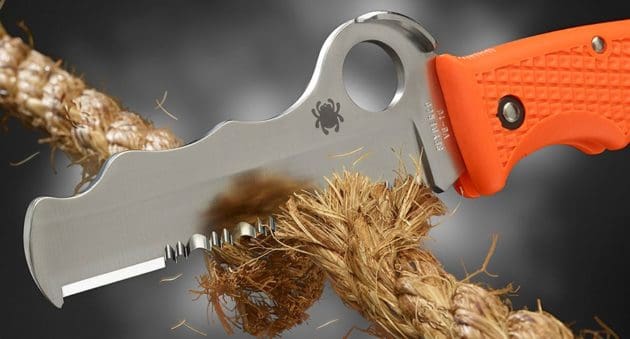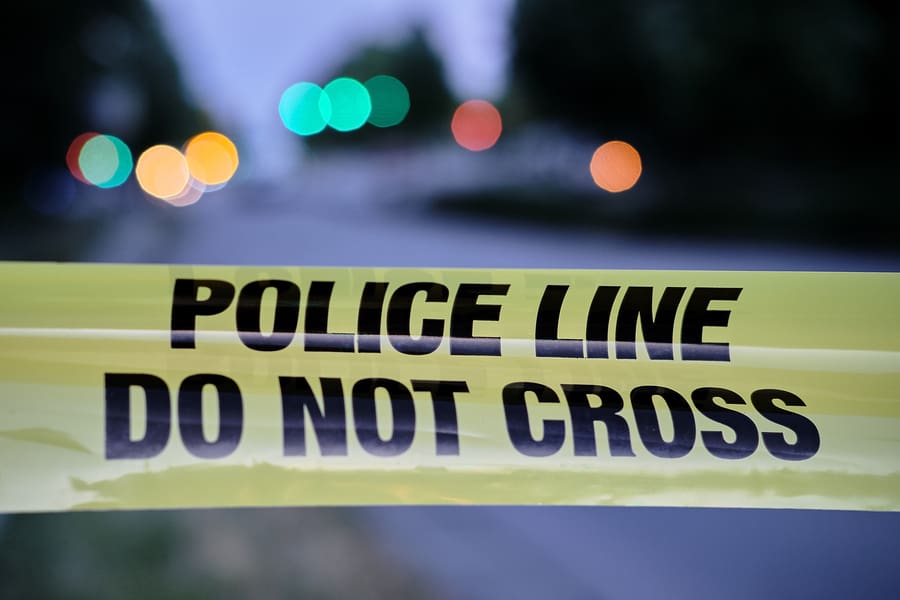Besides striking some people as uniquely beautiful, a strong, high-quality serrated blade can be a pleasure to use.
A common myth about serrated blades is that they’re less useful and a pain to sharpen. In reality, most people simply don’t know how to sharpen them, so they get intimidated—and they’re missing out.
There’s a reason the most trusted cutlery companies continue to make serrated blades.
A serrated edge gives you an advantage when cutting fibrous materials, including clothing, netting, and seat belts.
A nicely sized, easily maneuverable SpyderEdge™ knife is one of the best rescue, survival, and emergency tools you can have. It gives you speed and power when seconds matter and you need to cut through stubborn material as quickly as possible. It’s not an exaggeration to say a serrated blade can mean the difference between saving a life and losing one.&trade
Serrations protect your knife’s edge from heavy damage.
If you run into an obstacle while cutting (like a heavy staple in a box), a serrated edge will usually catch it and avoid the long grate or scrape that would make a plain edge instantly useless in the same situation. Yes, you might need to take the time to learn to care for it, but a good, tough serrated blade will flat out last longer, suffering minor damage where a plain edge would be completely ruined.
A serrated edge is a functionally longer cutting surface, which means it holds up much longer than you think without needing to be sharpened.
A SpyderEdge has a cutting edge surface area that is up to 24% longer than its PlainEdge counterpart. That means you will notice a big difference in its usability over time as well as how often you have to sharpen it. Where a serrated edge dulls in the points, when cutting through thick, unruly material, a straight edge dulls completely, like a much “softer” steel.

You’ll be surprised how much “the best of both worlds” holds true for a CombinationEdge™ (partially serrated) blade.
Survivalists in particular often find that a CombinationEdge blade is the best fit for for the way they use their knives. Anything you can do with a plain edge, from sharpening pencils to detailed work, you can do with a serrated blade, and you might even do it better.
It does come down to personal preference, and you won’t know what you prefer until you give it a try. That’s why it’s not a bad idea to pick up a CombinationEdge EDC and see how it performs as uses manifest themselves. You just might wonder what took you so long.
In the end, it’s about quality.
Even the biggest fans of serrated blades will tell you to steer VERY clear of cheap ones. There are so many factors involved, from the shape and spacing of the serrations to the choice of steel, that buying a poor quality serrated knife is a major waste of money and can even be dangerous.
Do your homework and reward yourself with a knife that was truly engineered to perform.
A note about sharpening:
Now that you’re sold on serrated edges (or at least curious about them), you might still have sharpening questions. Good news: Spyderco’s Tri-Angle Sharpmaker will do the job for any serrated or plain edge.
There are lots of tutorial resources out there, too, such as this brief video (below). Even better news: Spyderco will factory sharpen any of their serrated SpyderEdge blades free of charge; you only have to pay a $5 shipping cost.





I actually didn’t know I could just send in my serrated Spyderco and have it sharpened. I’m not sure what the increase in Spyderco paid content is but I don’t have a problem with this. I’ve learned a bunch about my favorite knives!
My local knife guy has one of his tradesman sharpeners come round the neighborhood in a mobile sharpening truck once a month. You can schedule him on Facebook. $6 for any serated knife done in my driveway. I don’t even sharpen my kitchen knives myself anymore. Sure, I have the stones, diamond files, Lansky’s, etc. but for a total of about $75 a year I get all of my knives sharpened for me. My time doing it myself would cost way more than that. Plus I help keep a good local business in business.
If only there was a website dedicated to telling The Truth About Knives where content like this could be posted…..
I’ve wondered why TTAK doesn’t get the traffic and regular hourly updates we get here… but then I realized that the majority of the world doesn’t consider blades as newsworthy as bullets… guess I’m weird that way. 🤠
There used to be
Nah, I ain’t buying it. Anything a serrated edge can do, a properly sharpened plain edge can do better. If the task at hand requires sawing, and you can’t baton with your knife, then you definitely need a saw and not a knife.
Truth.
My sentiments exactly
The only serrated pocket knife I’ve ever bought was some model of Shrade for like 11 bucks in 1997. I use it in kitchens, for breaking down cardboard. Never touched the blade and I’d say it still works about as well as it always has. On the other hand, if I forget it and use my daily (a green Delica or a Mini Grip) I need to sharpen almost right away afterwards.
If you cut a lot of cardboard the serrated edge comes into it own. But other than that, yeah, straight edge works just fine.
Don’t get me started on serrated steak knives… Even places that should know better saddle you with ’em.
That’s when I bust out my plain edge Balisong and use that as my steak knife, I’ve had a few people look at me like I just grew a second head.
If you cut a lot of cardboard (corrugated), don’t use your EDC at all. Use a disposable utility knife. Corrugated is murder on an edge. Some people even use it to sharpen and strop.
I like the lock blade folding utility knives with the thumb stud that take the trapezoid shaped blades. I have a bunch of them.
. Serra’s fine for rope and string. Not so great on skinning things
I’m sure that’s a wonderful sharpener, but $104.00?
Spyderco matriarch with the wave opener best edc I’ve had in a while
Spyderco has always worked hard to offer new and unique designs many which are for specific ( read limited) markets. I appreciate their enthusiasm and talent. I carry the basic Military model.
Sharp steel. What a great idea.
Check out the VEFF serations on CRKT knives. Better then triple point I my opinion. 🙂
The spyderco sharpmaker sharpener is a good basic set up, if you have serrations you probably should have a sharpmaker to go along with it…what kind of man sends his knife out to be sharpened anyway…maybe the same kind who’s wife does the turkey carving?
In a time when I had to cut a lot of cardboard, and I mean the heavy stuff 5 days a week, serrated blades proved to be the worse…everything dulls, and a dull serration catches and holds fibers…the best blade I used for boxes was an opinel #10…touched up every day, given a good sharpening every week. It was the box breakdown champ of that horrible time of my life.
Bottom line there is a time and place for both plain edge and serrations.
Comments are closed.